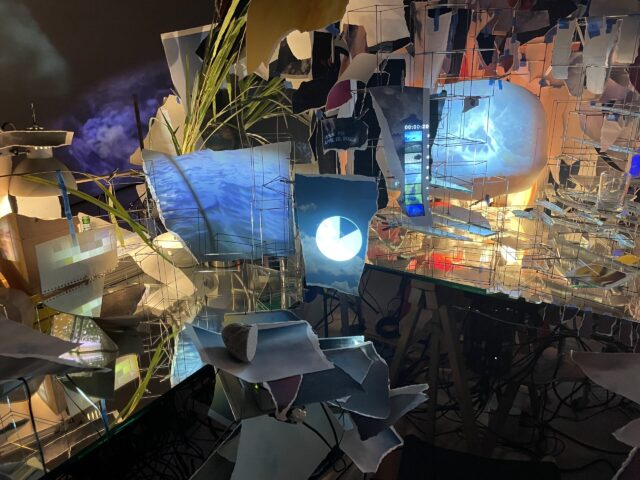
Sarah Sze, Timekeeper, detail, mixed media, 2016 (photo by twi-ny/mdr)
SARAH SZE: TIMELAPSE / GEGO: MEASURING INFINITY
Solomon R. Guggenheim Museum
1071 Fifth Ave. at 89th St.
Through September 10, $19-$30
212-423-3587
www.guggenheim.org
sarah sze: timelapse online slideshow
A pair of wonderful exhibits that contemplate time and space through striking, fragile visuals come to a close this weekend; be sure to make time to see them.
“Gego: Measuring Infinity” is a career retrospective of Hamburg-born Venezuelan artist Gertrud Goldschmidt, known as Gego. Nearly two hundred works are on view, arranged chronologically and thematically, dating from the early 1950s to the early 1990s; Gego died in 1994 at the age of eighty-two, leaving behind a plethora of sculptures, textiles, drawings, prints, sketches, watercolors, letters, artist’s books, and more. “To visualize a solution is what matters: to make visible that which still does not exist outside of me,” she said.
An architect and engineer who fled the Nazis, Gego used such materials as bronze, steel, aluminum, iron, nylon, copper, plastic, and lead to create three-dimensional structures that are like line drawings in space — she even calls some Drawing without Paper — appearing so delicate that you might think you can blow them apart (but please don’t try). On the floor, on tables, and hanging from the ceiling, the works evoke scientific helixes and nets, with titles that often explain what they are: Cube in Sphere, 12 Concentric Circles, Four Red Planes, Eight Squares. Gego’s ink-on-paper pieces play with grids and offer optical illusions that delight the eye.
“Gego: Measuring Infinity” is brilliantly paired with “Sarah Sze: Timelapse,” in which the Boston-born, New York City–based Sze incorporates elements of the Guggenheim’s spiraling Frank Lloyd Wright building — both outside and inside — into complex, spirited installations that explore time and space while revealing much of her creative process. Combining cutting-edge digital technology with tireless handwork and large-scale paintings, Sze invites visitors to marvel at the nearly impossibly detailed works, which feature plants, a pendulum hovering over water, tools, clothespins, thread, ladders, writing implements, coffee cups, tape, lamps, salt, string, wood, cords, mirrors, fans, remote controls, books, dice, and live video feeds and projections. “I often use found objects because they are scaled to me, like a compass for my own body,” Sze says. Be careful where you step; it appears that the constructions can fall apart with one tiny misstep.
Sze’s imagination extends to the titles; works have such names as The Moon’s Gravity Causes the Oceans’ Tides, Travelers Among Streams and Cascades, Images that Images Beget, The Night Sky Is Dark Despite the Vast Number of Stars in the Universe, and Things Caused to Happen (Oculus). As Sze explains, her installations consider “how we mark and measure time — constructing our own personal timelines of memory through images and fragments of experiences that are constantly evolving.” Evoking Gego, Sze also notes, “There is fragility in drawing a line through space; with this one simple powerful gesture, you can occupy an entire space.”
The show concludes at the top tower with 2016’s Timekeeper, a multimedia marvel that gets its own room. Myriad objects and projections are on and surround a desk, offering a look inside the mind of this wildly talented artist, who calls the exhibition “a contemplation on how we mark time and how time marks us.” She adds, “Every exhibition is a timekeeper. Art is a way to have a conversation over time. The show becomes almost like a forensic site for an installation or an archaeology site for a series of works, so you see the process of making, the evidence of that process left over, live in the space.” Happy digging!
[Mark Rifkin is a Brooklyn-born, Manhattan-based writer and editor; you can follow him on Substack here.]